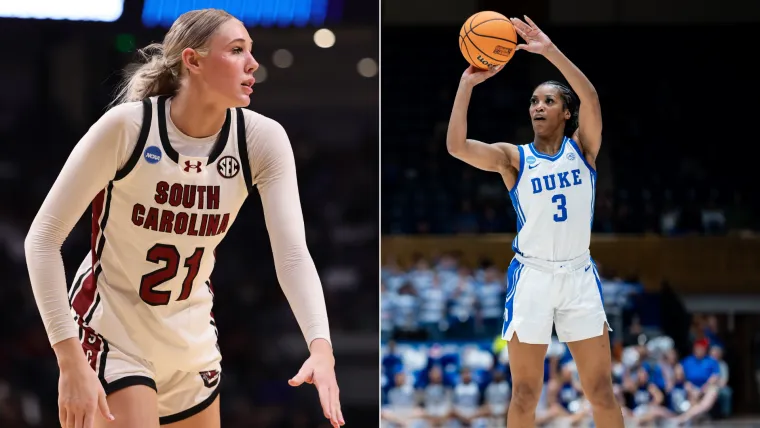The 2024 NCAA Women’s Basketball Tournament saw numerous upsets and thrilling games, with top-tier teams battling it out for a spot in the Final Four. Among those teams, the Duke Blue Devils had an impressive run, reaching the Elite Eight for the first time in several years. However, their dreams of advancing to the Final Four were crushed by the defending national champions, the South Carolina Gamecocks, in a highly anticipated Elite Eight matchup. While Duke put up a valiant fight, ultimately, it was South Carolina’s dominance and experience that proved to be the decisive factors in their 82-58 victory.
This game, while heartbreaking for the Blue Devils and their fans, provided valuable lessons and insights for the Duke women’s basketball program. The performance against South Carolina highlighted strengths, weaknesses, and areas of growth that will be essential for the program’s future. Below are the most important takeaways from the game:
1. South Carolina’s Physicality and Depth Were Overwhelming
South Carolina, under the leadership of head coach Dawn Staley, has built a reputation as one of the most physically dominant teams in women’s college basketball. With an abundance of talent, size, and athleticism, the Gamecocks present challenges for any team they face. In this Elite Eight game, they once again showcased their depth and physicality.
One of the most striking aspects of the game was how South Carolina’s size and strength wore down Duke over the course of the 40 minutes. The Gamecocks’ frontline, led by the 6’5” Aliyah Boston, was simply too much for Duke’s defenders to handle. Boston, one of the top players in the country, was a constant presence in the paint, scoring, rebounding, and disrupting Duke’s attempts to establish their own rhythm offensively. South Carolina out-rebounded Duke by a margin of 20 boards (50-30), including 16 offensive rebounds, which allowed them to extend possessions and demoralize the Blue Devils.
South Carolina’s depth was also a crucial factor. Players like Laeticia Amihere, Zia Cooke, and Brea Beal provided a wealth of talent off the bench, ensuring that there was no drop-off in intensity or skill level when substitutions were made. For Duke, this was a challenge, as they simply did not have the same kind of depth or size to match the Gamecocks in the post. The Gamecocks’ ability to wear Duke down physically was an important difference-maker in this game, and it speaks to the level of talent that South Carolina has built over the years.
2. Duke’s Defense Was Overmatched in the Paint
Duke’s defense, while strong throughout the regular season, was significantly outmatched in the paint against South Carolina. The Gamecocks’ size advantage was evident from the beginning, and it led to several key mismatches that Duke struggled to overcome.
Aliyah Boston dominated in the low post, scoring efficiently and drawing fouls, which limited Duke’s defensive options. While Duke’s defense focused on collapsing around Boston and doubling her at times, it opened up opportunities for other South Carolina players, such as Amihere and Cooke, to capitalize. These players were able to finish in the paint and also generate second-chance opportunities with offensive rebounds.
Duke’s defense was generally solid in terms of perimeter play, but they were unable to contain South Carolina’s dominance inside, particularly in the second half. This inability to secure defensive rebounds and defend the post put Duke at a disadvantage, forcing them to play catch-up for much of the game. Additionally, the Blue Devils were often forced to foul in order to prevent easy baskets in the paint, which resulted in free throw opportunities for South Carolina.
3. Duke’s Offensive Struggles Against South Carolina’s Pressure
One of the more frustrating aspects of the game for Duke was their offensive struggles, particularly against South Carolina’s defensive pressure. The Gamecocks are known for their aggressive, high-pressure defense, and they effectively neutralized Duke’s offensive flow by forcing turnovers and disrupting passing lanes.
Duke’s ball handlers struggled to break South Carolina’s press, and the Blue Devils often found themselves hurried in their offensive possessions. South Carolina’s defense created turnovers that led to fast-break points, which further contributed to the Gamecocks’ domination. While Duke had solid offensive pieces such as Celeste Taylor and Elizabeth Balogun, they were not able to consistently break through South Carolina’s defense.
The Blue Devils shot only 38.5% from the field, and their three-point shooting, which had been a strength earlier in the tournament, was limited to just 5-20 (25%) in this game. South Carolina’s size and length in the passing lanes made it difficult for Duke to get clean looks, and their lack of offensive execution in crucial moments led to missed opportunities to chip away at the Gamecocks’ lead.
4. The Impact of Inexperience in High-Stakes Games
Duke’s run to the Elite Eight was a remarkable achievement, especially considering that they were not considered among the top contenders at the start of the season. However, one of the critical factors in this game was the inexperience of Duke’s players in high-stakes matchups against an elite program like South Carolina.
While Duke had several talented players, they lacked the kind of championship pedigree and experience that South Carolina brought to the table. The Gamecocks have consistently been in the hunt for national titles, and their players, including Boston and Cooke, are battle-tested in high-pressure situations. For Duke, this was a learning experience that exposed the gap in postseason experience.
Throughout the game, Duke’s younger players appeared to be rattled at times by the intensity of the moment. Their decision-making, particularly in the second half, became increasingly hurried and less precise. South Carolina, by contrast, remained poised and made smart plays to extend their lead. This experience gap is something that Duke will need to address as they look to continue building a program that can challenge for championships in the coming years.
5. Bright Future for Duke Women’s Basketball
Despite the disappointment of their Elite Eight elimination, there are numerous reasons to be optimistic about the future of Duke women’s basketball. Head coach Kara Lawson has built a solid foundation for the program, and her recruiting efforts have brought in top-tier talent. The Blue Devils have a strong core of players who can continue to develop and help elevate the program to greater heights in the coming years.
Players like Celeste Taylor and Elizabeth Balogun are key pieces for Duke moving forward. Taylor, in particular, was a standout for the Blue Devils in this game and has shown that she can perform at a high level on the biggest stage. Additionally, Duke has a strong recruiting class coming in, which includes players with the potential to impact the program immediately. With continued development under Lawson’s leadership, Duke women’s basketball could soon be a regular fixture in the Final Four and beyond.
6. Key Areas for Improvement
While Duke’s loss to South Carolina was a tough pill to swallow, it also highlighted several key areas for improvement moving forward:
- Rebounding: As mentioned earlier, Duke was significantly out-rebounded by South Carolina. This will be a point of emphasis for the team going forward. They will need to get stronger in the paint and work on securing defensive and offensive rebounds to be competitive against the top teams.
- Offensive Efficiency: Duke’s shooting was inconsistent, and they struggled to generate good looks against South Carolina’s defense. Developing a more efficient offensive game plan, especially in high-pressure situations, will be crucial for Duke’s future success.
- Experience in Big Games: Building the experience necessary to succeed in elite tournament games will be important. While this season’s Elite Eight appearance is a step in the right direction, Duke must continue to put their players in big-game situations to prepare them for future success.



